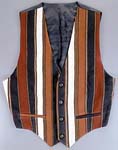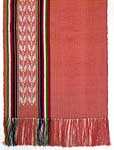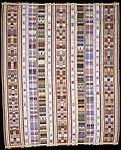
Until some 50 years ago, Madagascar was home to a variety of flourishing weaving traditions. The island's markedly divergent ecological zones made available a wide range of fibers. Raffia was prominent on the island's east and west coasts. In the southeast, the Malagasy produced fabrics from reeds and beaten and spun bark fibers. The south and west were noted for textiles of cotton and wild silk. In the central highlands, the Malagasy used hemp, banana stem, domesticated mulberry silk and other fibers in weaving. Women spun, dyed and wove fibers into panels of cloth, which were most often left untailored and gracefully wrapped around the body. Men wore a narrow panel as a loincloth, and both men and women wore rectangular, striped outer wrappers.Despite a decline in much of the early 20th century, the beginning of the new millennium finds both resiliency and revival in the production of handwoven cloth. Today, although nearly all Malagasy choose to dress in factory-made cloth of Western tailoring, woven textiles remain important gifts from the living to revered ancestors. Revival of royal textile patterns and a flourishing contemporary fashion scene incorporating handwoven shoulder wraps and tailored clothing ensure the continued importance of Madagascar's textile arts.

 In
urban areas throughout Madagascar, most notably in the capital city of Antananarivo,
local fibers, cloth styles and hand weaving are the rage in high fashion.
Since the mid-1990s, local fibers have dominated the runways of Manja, the
annual national fashion review. Some textile designers supply fine fabrics
for apparel to internationally renowned fashion houses like Yves St. Laurent.
Others, such as Eric Raisina, himself a Manja winner, have gone on to successful
careers designing haute-couture creations for those companies. In
urban areas throughout Madagascar, most notably in the capital city of Antananarivo,
local fibers, cloth styles and hand weaving are the rage in high fashion.
Since the mid-1990s, local fibers have dominated the runways of Manja, the
annual national fashion review. Some textile designers supply fine fabrics
for apparel to internationally renowned fashion houses like Yves St. Laurent.
Others, such as Eric Raisina, himself a Manja winner, have gone on to successful
careers designing haute-couture creations for those companies.
 Beyond
this exclusive world of high fashion, many urban Malagasy are again embracing
locally woven fabrics. Elegant silk and multifiber shoulder wraps grace
Malagasy women of all ages. Western-inspired silk fashion accessories, such
as vests, ties, handbags and hats make creative use of local fibers and
are popular with affluent Malagasy and increasingly with tourists. Madagascar's
prominence in textiles has also been noted by international clothing manufacturers,
which have set up clothing factories in Madagascar. Beyond
this exclusive world of high fashion, many urban Malagasy are again embracing
locally woven fabrics. Elegant silk and multifiber shoulder wraps grace
Malagasy women of all ages. Western-inspired silk fashion accessories, such
as vests, ties, handbags and hats make creative use of local fibers and
are popular with affluent Malagasy and increasingly with tourists. Madagascar's
prominence in textiles has also been noted by international clothing manufacturers,
which have set up clothing factories in Madagascar.

 Madagascar's
weft-design textiles known as akotofahana-- largely abandoned by
the late 19th century--underwent a transformation among Malagasy weavers
in the 20th century. Formerly associated with nobles, these cloths became
a standard form of female attire in the form of shoulder wraps. Instead
of the bright colors of the past, women preferred a more subdued white
wrap embellished with new, mostly floral motifs such as roses and grapevines. Madagascar's
weft-design textiles known as akotofahana-- largely abandoned by
the late 19th century--underwent a transformation among Malagasy weavers
in the 20th century. Formerly associated with nobles, these cloths became
a standard form of female attire in the form of shoulder wraps. Instead
of the bright colors of the past, women preferred a more subdued white
wrap embellished with new, mostly floral motifs such as roses and grapevines.
Today, highland women are showing a renewed interest in the striking color combinations and historic motifs of the past. Decorative bands of geometric and floral weft-float patterns embellish the cloths, illustrating the technical expertise of the weaver. The cloths are increasingly popular export items sold in boutiques in Europe and the United States.

 Madagascar's
stunning akotofahana cloths--prized by Europeans in the 19th century
as the sparkling jewels of Malagasy textile arts--enjoyed a revitalization
in the 1990s. A British art historian, Simon Peers, combined forces with
a group of Merina weavers who shared his respect for this historic art
form. Together they created the weaving workshop now known as Lamba SARL.
The group researched and recreated many 19th-century akotofahana
patterns found in the collections of the Queen's Palace of Antananarivo
(destroyed by fire in 1995) and the British Museum in London. Madagascar's
stunning akotofahana cloths--prized by Europeans in the 19th century
as the sparkling jewels of Malagasy textile arts--enjoyed a revitalization
in the 1990s. A British art historian, Simon Peers, combined forces with
a group of Merina weavers who shared his respect for this historic art
form. Together they created the weaving workshop now known as Lamba SARL.
The group researched and recreated many 19th-century akotofahana
patterns found in the collections of the Queen's Palace of Antananarivo
(destroyed by fire in 1995) and the British Museum in London.
Lamba SARL textiles are not merely faithful recreations of older textiles. Rather, they combine 19th-century patterns and techniques with new ones while reviving a number of laborious and complex weaving techniques that had been abandoned by the late 19th century. Each Lamba SARL textile is a unique, handwoven tour de force, and Lamba SARL creations are now part of museum and private collections in Europe and the United States.
Pictured above
Antananarivo, the capital of Madagascar
Photograph by Wendy Walker, 1991
Man's striped vest, arindrano pattern
Betsileo peoples, Madagascar
2000
Wild and mulberry silk, dye
National Museum of African Art, Smithsonian Institution,
museum purchase, 2000-13-24
The striped pattern in this vest is similar to patterns used in woven burial cloths.
Wrapper (lamba akotofahana or
lamba mpanjaka)
(Lamba Sarl workshop)
Merina peoples, Madagascar
Silk, dye
National Museum of African Art, Smithsonian Institution, museum purchase, 2001-2-1
This stunning textile is the most complex cloth created to date at the Lamba Sarl workshop. It combines both warp and weft designs and includes a distinctive border treatment of warp banding and a knotted fringe--techniques that have not been done since the mid-19th century.
|

